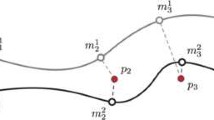Abstract
Wearable computers have the potential to act as intelligent agents in everyday life and to assist the user in a variety of tasks, using context to determine how to act. Location is the most common form of context used by these agents to determine the user's task. However, another potential use of location context is the creation of a predictive model of the user's future movements. We present a system that automatically clusters GPS data taken over an extended period of time into meaningful locations at multiple scales. These locations are then incorporated into a Markov model that can be consulted for use with a variety of applications in both single-user and collaborative scenarios.













Similar content being viewed by others
References
Ashbrook D, Starner S (2002) Learning significant locations and predicting user movement with GPS. In: Proceedings of the 6th IEEE International Symposium on Wearable Computers, Seattle, WA, 7–10 October 2002
Bhattacharya A, Das SK (1999) LeZi-update: an information-theoretic approach to track mobile users in PCS networks. In: Proceedings of the International Conference on Mobile Computing and Networking, Seattle, WA, August 1999
Chang J-H, Tassiulas L (2000) Energy conserving routing in wireless ad-hoc networks. INFOCOM (1):22–31
Csinger A (1995) User models for intent-based authoring. Dissertation, The University of British Columbia
Cybiko, Inc. http: //www.cybiko.com.
Davis JA, Fagg AH and Levine BN (2001). Wearable computers as packet transport mechanisms in highly-partitioned ad-hoc networks. In: Proceedings of the 5th IEEE International Symposium on Wearable Computers, Zürich, Switzerland, 8–9 October 2001
Duda RO, Hart PE and Stork DG (2001) Pattern classification. Wiley, New York
Garmin, Inc. GPS 35 LP TracPak GPS smart antenna technical specification. http://www.garmin.com/products/gps35/.
GeoStats, Inc. http: //www.geostats.com.
Hudson JM, Christensen J, Kellogg WA and Erickson T (2002) I'd be overwhelmed, but it's just one more thing to do: availability and interruption in research management. In: Proceedings of the Human Factors in Computing Systems Conference (CHI 2002), Minneapolis, MN, 20–25 April 2002
Kistler J, Satyanarayanan M (1992) Disconnected operation in the coda file system. ACM Trans Comp Sys 10(1):3–25
Kortuem G, Schneider J, Suruda J, Fickas S, and Segall Z (1999) When cyborgs meet: building communities of cooperative wearable agents. In: Proceedings of the 3rd IEEE International Symposium on Wearable Computers, San Francisco, CA, 18–19 October 1999
Liu GY, Maguire GQ (1995) Efficient mobility management support for wireless data services. In: Proceedings of the 45th IEEE Vehicular Technology Conference, Chicago, IL, July 1995
Marmasse N, Schmandt C (2000) Location-aware information delivery with ComMotion. In: Proceedings of the Second International Symposium on Handheld and Ubiquitous Computing (HUC), Bristol, UK, 25–27 September 2000
Orwant J (1993) Doppelgänger goes to school: machine learning for user modeling. Master's thesis, Massachusetts Institute of Technology
Roth J, Unger C (2000) Using handheld devices in synchronous collaborative scenarios. In: Proceedings of the Second International Symposium on Handheld and Ubiquitous Computing (HUC), Bristol, UK, 25–27 September 2000
Sparacino F (2002) The museum wearable: real-time sensor-driven understanding of visitors' interests for personalized visually-augmented museum experiences. In: Proceedings of Museums and the Web, Boston, MA, April 2002
Stirling B (1998) Distraction. Spectra, Pittsburgh, PA
Terry M, Mynatt ED, Ryall K and Leigh D (2002) Social net: using patterns of physical proximity over time to infer shared interests. In: Proceedings of the Human Factors in Computing Systems Conference (CHI 2002), Minneapolis, MN, 20–25 April 2002
Wolf J, Guensler R and Bachman W (2001) Elimination of the travel diary: an experiment to derive trip purpose from GPS travel data. In: Proceedings from the Transportation Research Board 80th annual meeting, Washington, DC, 7–11 January 2001
Acknowledgements
Many thanks to Jan-Derk Bakker for writing a Monte Carlo simulator. Thanks to Graham Coleman for writing visualisation tools and to MapBlast (http://www.mapblast.com) for having freely available maps. Funding for this project has been provided in part by NSF career grant number 0093291.
Author information
Authors and Affiliations
Corresponding authors
Rights and permissions
About this article
Cite this article
Ashbrook, D., Starner, T. Using GPS to learn significant locations and predict movement across multiple users. Pers Ubiquit Comput 7, 275–286 (2003). https://doi.org/10.1007/s00779-003-0240-0
Received:
Accepted:
Published:
Issue Date:
DOI: https://doi.org/10.1007/s00779-003-0240-0




